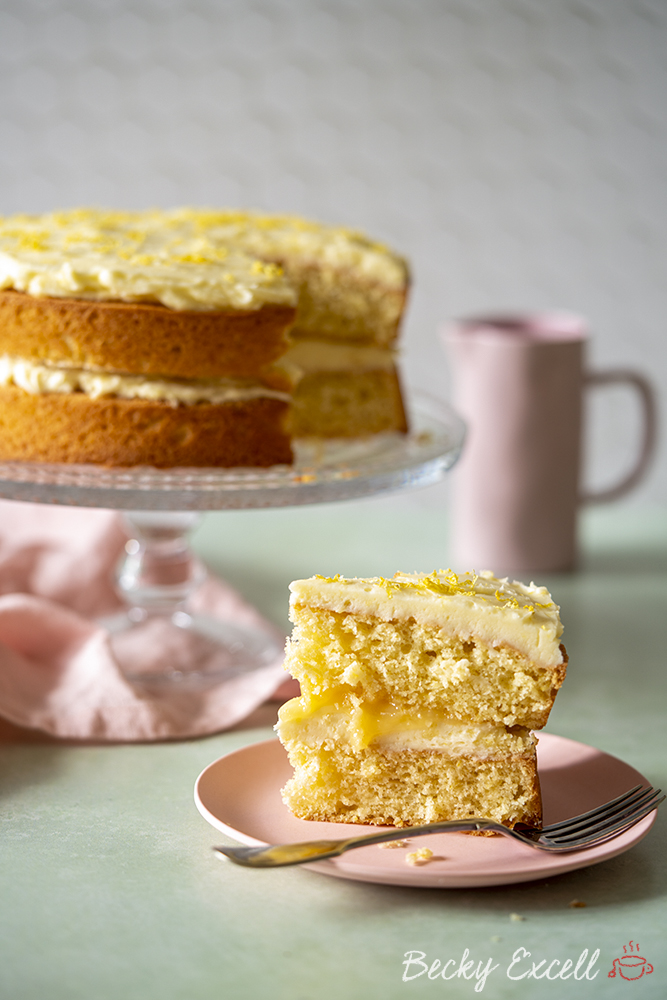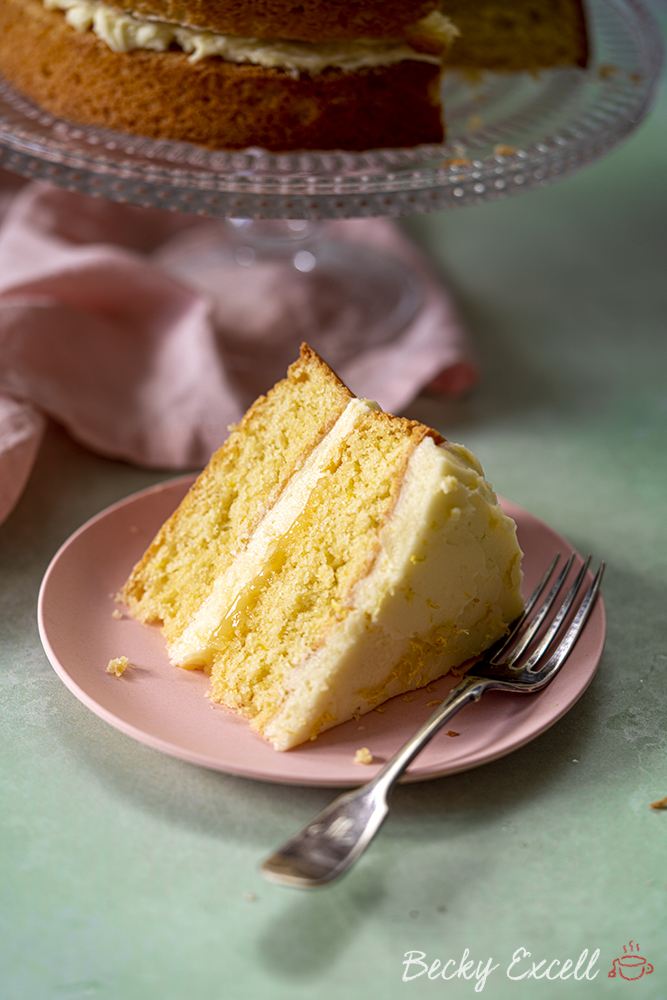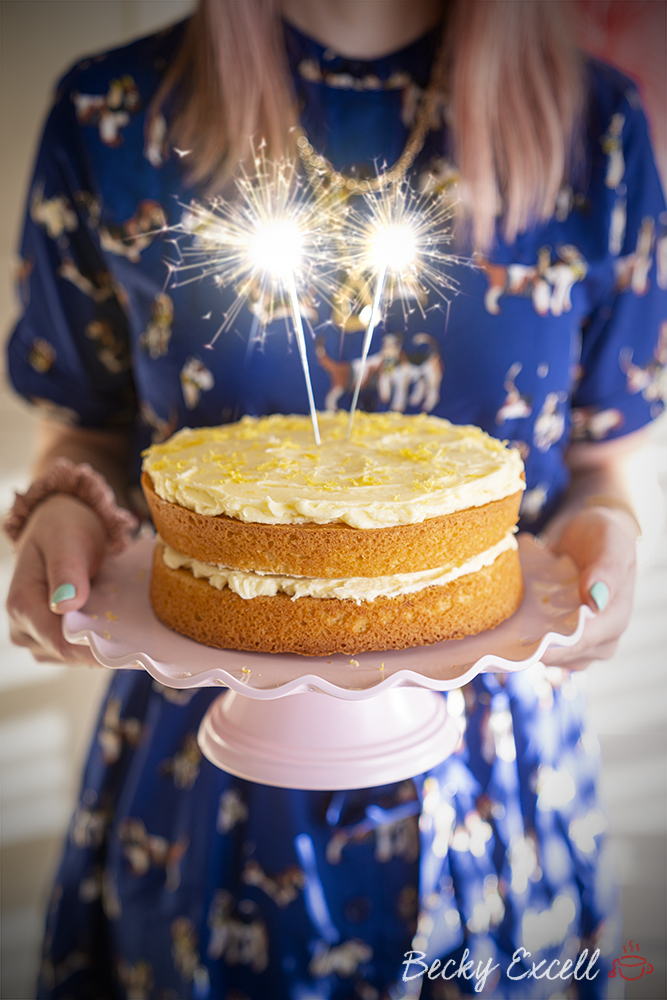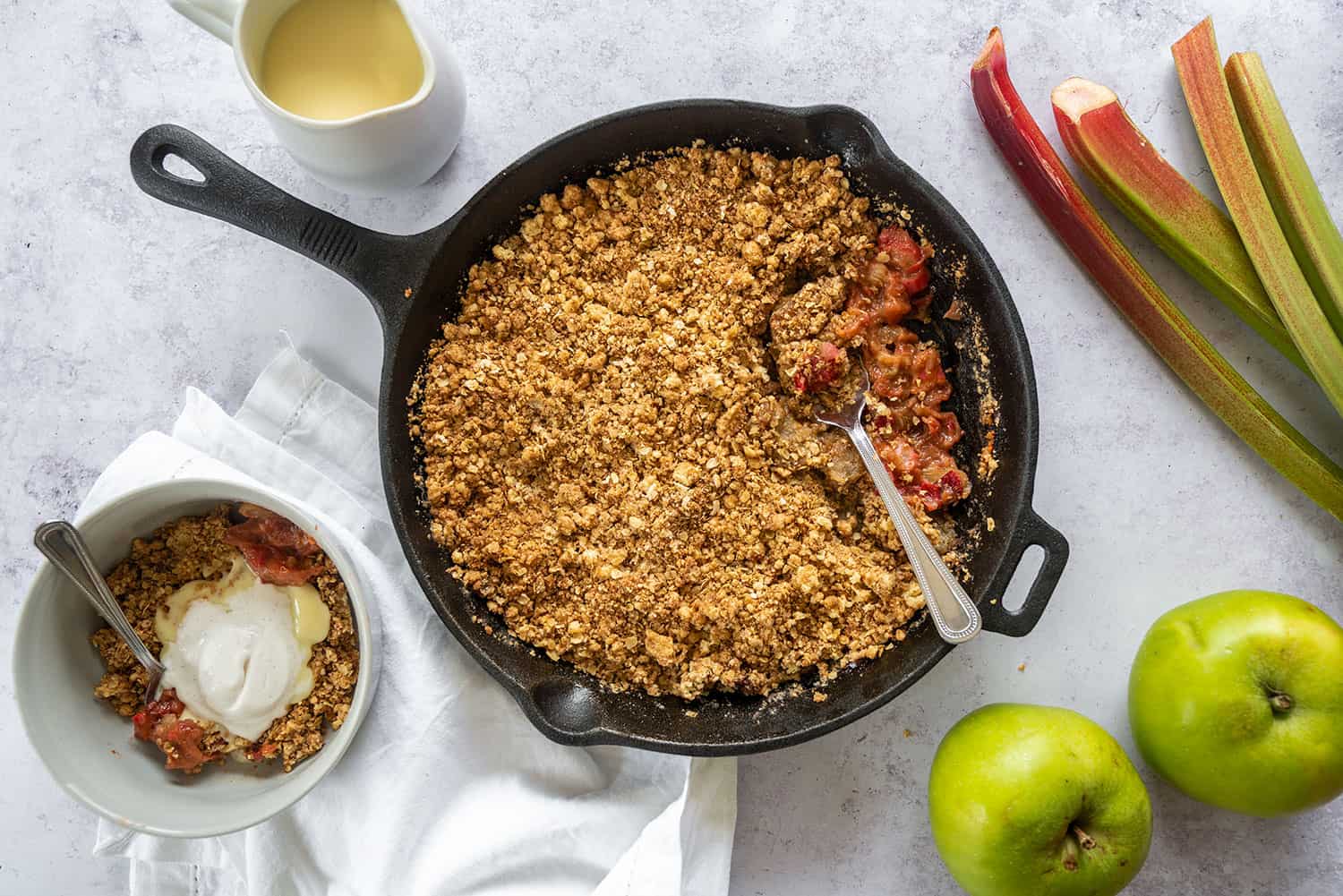Gluten-free lemon cake recipe – one of the easiest cakes you’ll ever bake and 100% beginner-friendly. Best of all, nobody would know it’s Coeliac-friendly and wheat-free!
Gluten-free lemon cake recipe, anyone? It doesn’t get simpler or more delicious than this beauty and it’s the perfect, easy-to-bake cake for birthdays and celebrations – or even just when you’re celebrating nothing!

A sweet, sharp and zesty lemon sponge cake has always been my go-to bake for any special occasion – even before I was ‘sentenced’ to a lifetime gluten-free diet!
And 10+ years into my gluten-free voyage, that still hasn’t changed. Why? Well, a cake like this is just so simple to bake, construct and decorate (you literally can’t go wrong) and never fails to please a crowd.
That’s why this recipe was one of the first that I ever adapted to be gluten-free. Fortunately, it turned out exactly as I hoped it would; it was identical to the lemon sandwich cake I used to bake many years ago!
Even to this day, I still bake it whenever I get an excuse: most recently for my own birthday as you’ll see in the photos!! Because… why not?
Gluten-free lemon cake recipe: What you’ll need…
- Butter – Butter is king in cakes and buttercream, but make sure yours is softened before beginning. Leaving it out of the fridge for a couple of hours should do it.
- Caster sugar: Of course, sugar isn’t just for sweetness – it helps to achieve a lovely crisp exterior and helps the cake to form a perfect crumb.
- Eggs: I used medium eggs for this recipe, but large will be fine too. No need to reduce how many eggs used if using large eggs!
- Lemons – You can’t beat fresh lemons when it comes to zest. You’ll need these for juice and zest.
- Gluten-free self-raising flour: I use a simple commercial blend from the free from aisle in the supermarket. If you can’t find a blend like this where you live, you can always make your own using my gluten-free flour recipe.
- Gluten-free baking powder – Though there’s a little of this in gluten-free self-raising flour, a little goes a long way to ensure a nice, perfect rise. Adding too much has the opposite effect – you cake will sink in the middle!
- Xanthan gum: This helps to bind the cake crumb together so it doesn’t become crumbly, replacing the gluten that would otherwise do the same job.
- Icing sugar – You’ll need this for the buttercream as caster sugar won’t cut it whenever it comes to creating icing.
- Lemon curd – Either use store-bought or make your own using my recipe. Cheaper lemon curd tends to look a little see-through and more expensive looks a little more creamy and yellow, just so you know!

So what does my gluten-free lemon cake taste like?
The sponge itself is zesty, moist, light and (believe it or not) not crumbly and dry like some might assume of a gluten-free sponge.
Next, you’ve got a whipped, fluffy lemon buttercream and a layer of lemon curd, that’ll greet your taste buds in every bite. Trust me – you won’t be disappointed with the lemon-y flavour with this one!
This one really is a timeless classic that, in my experience, everyone loves. And you will too!
How do I serve my gluten-free lemon cake?
It’s totally up to you, but here’s a few ideas:
- With a good cuppa – Earl grey tea or even green tea are perfect pairings – flavour-wise.
- With a glass of Prosecco – Perfect for a little boozy celebration.
- With candles or cake sparklers for celebrations – Remember: life is too short to go without gluten-free cake on your birthday!
- As a part of gluten-free afternoon tea – A few slices of this beauty will be a key part of the sweet part of any afternoon tea. It’d be perfect alongside my gluten-free scones, gluten-free battenberg and gluten-free chocolate brownies.
Gluten-free lemon cake recipe: Frequently Asked Questions
Can I make this recipe gluten-free? Is it suitable for Coeliacs?
It is gluten-free, though nobody would know just by tasting it – trust me!
Bear in mind that minimising cross-contamination is hugely important if you’re Coeliac or making this for someone who is. Here’s some tips from Coeliac UK on minimising the risk of cross contamination.
Also, make sure that all ingredients used don’t have any gluten-containing ingredients. Then make sure that they also don’t have a ‘may contain’ warning for gluten, wheat, rye, barley, oats (which aren’t gf), spelt and khorasan wheat (aka Kamut).
Here’s some more info from Coeliac UK on identifying safe gluten-free products.
Can I make your gluten-free lemon cake recipe dairy-free?
Yes! Here’s the simple swaps you need to make:
- Use Stork hard margarine instead of butter.
- If using lemon curd, ensure it’s dairy-free or make your own dairy-free lemon curd using my recipe.
Can I make your gluten-free lemon cake recipe vegan?
Yep! If you follow the instructions above to make this recipe dairy free, then all you’ve got left to contend with is the eggs.
There’s eggs in lemon curd, so make sure you use a gluten-free and vegan alternative, make your own or omit it entirely.
Here’s a few ideas you can use as egg replacements for the sponge, so each of these = 1 egg.
- 3 tablespoons of aquafaba – water from a can of chickpeas. Make sure you whisk it up until frothy before adding.
- Egg replacement powder – I’d recommend using Orgran as it’s gluten free.
- 1 tablespoon of chia/flax seeds mixed with 2 tablespoons of water and left for 10 minutes in the fridge.
- 3 tablespoons of applesauce.
I haven’t tested all of these egg alternatives so let me know how you get on in the comments below.
Is this recipe low FODMAP?
For once, this recipe is actually low FODMAP and suitable for the elimination phase of the diet. No changes required!
Of course, ensure you check all your ingredients to ensure there’s no hidden high FODMAP ingredients hiding.

Should I use store-bought or homemade lemon curd?
Either – it’s up to you!
I used this lemon curd from Tesco to make this most recently, but usually, I make my own when I have time using this recipe.
Can I make your gluten-free lemon cake recipe using a stand mixer or electric whisk?
Of course you can, but you definitely don’t need to. I use both a stand mixer and an electric whisk for this recipe. Here’s a link to the electric whisk I use.
A stand mixer makes making buttercream a breeze (makes light work of longer periods of mixing) and an electric whisk speeds up mixing the cake batter (which is perfect for short blasts of mixing).
Whilst mixing the cake by hand is easy peasy, making the buttercream can take a little longer by hand. Just ensure you mix everything in thoroughly!
Do I need weighing scales to make your gluten-free lemon cake recipe?
In short… yes, yes and yes! And I wouldn’t advise attempting any my recipes without them. One of the worst things you can do in any recipe is alter the quantities by mistake or on purpose.
Why? Well, you’re sort of just gambling with the recipe and praying that it turns out ok, don’t you think? And I’ve generally already done the hard work there for you, so you don’t have to do the guesswork with measurements!
A lot of work went into fine tuning ratios and quantities so I wouldn’t mess around with them unless you really know your stuff. I’d recommending using digital cooking scales like these so you know you’re getting an accurate measurement and replicating my recipe as accurately as poss.

Gluten-free lemon cake recipe: Tips for perfect bake every time
- If your sponge mixture splits, don’t panic! It should sort itself out once you add in the gluten-free self-raising flour. This happens due to the large amount of wet ingredients and doesn’t affect the end result whatsoever.
- Please don’t try to ice the cake whilst its still warm. Not surprisingly, buttercream contains butter, which yes, will melt!
- When splitting your cake mixture into two round baking tins, weigh both of them as you pour in the mixture. This will ensure both sponges are the perfect size.
- Using different size cake tins will affect bake time. I used two round 8in baking tins for this recipe – as a general rule of thumb, larger sized tins will mean it bakes quicker and smaller tins will mean it’ll need longer in the oven.
- Use a skewer or cake tester to check if your sponges are done in the middle. Just give it a poke in the middle – if it comes out clean, it’s done! If it comes out wet, then pop it back in for longer.


Gluten-free Lemon Cake Recipe
Ingredients
For the sponge:
- 225 g butter softened (use Stork hard margarine if dairy-free)
- 225 g caster sugar
- 4 eggs
- zest of 3 lemons
- 1-2 tsp lemon juice
- 225 g gluten-free self raising flour
- 1 tsp gluten-free baking powder (ensure it’s gluten free)
- 1/4 tsp xanthan gum
For the buttercream:
- 225 g butter softened (use Stork hard margarine if dairy-free)
- 450 g icing sugar
- zest of 2 lemons
- 2 tbsp lemon juice
To finish:
- lemon curd ensure dairy-free if necessary
- zest of 1 lemon to decorate
Instructions
For the sponge:
- Preheat your oven to 160C Fan / 180C and prepare 2 20cm round cake tins – prepare them with non stick baking paper.
- Place all your sponge ingredients into a large mixing bowl and whisk until well combined and thoroughly mixed (1 minute should do it).
- Divide the mixture between the two tins evenly.
- Bake for around 25-30 minutes until golden (remember never to open the oven until you think they are definitely done). To check if the sponges are cooked, insert a skewer and if it comes out clean, it's done!
- Leave the sponges in their tins for about 5 minutes before turning them out onto a cooling rack.
For the buttercream:
- Ensure your butter is soft and at room temperature. I find it takes a good hour out of the fridge to soften, but never let it go too soft! Place your butter into a stand mixer (or use an electric hand mixer) and mix on a medium speed for about 3-5 minutes until the butter has gone a lot more pale in colour.
- Add your icing sugar gradually. I add it in 2-3 stages and beat for about 3 minutes between each addition. Start your mixer slowly to save your kitchen from a real icing sugar mess, but then increase the speed to medium / high for each of your 3 minutes.
- Add your lemon juice and zest and mix once more. It should now be done. Ensure it's the right thickness – it should be if you've beaten it for long enough. However, if it's too thick you can add a tiny amount of milk. And if too thin, sieve in a little extra icing sugar.
For assemble:
- Carefully place one of your sponges onto your serving plate and spread a layer of the lemon buttercream of top all the way to the edges.
- Then spread a layer of lemon curd on top, not quite to the edges as once its sandwiched it will spread further.
- Carefully place the top layer on and spread with the top with more lemon buttercream.
- Sprinkle the top with extra lemon zest to finish.
Nutrition
Thanks for reading all about my gluten-free lemon cake recipe! If you make it, I’d love to see how it turned out so don’t forget to take a snap of your creations and tag me on Instagram!
Any questions about the recipe? Please do let me know by following me on Instagram and leaving me a comment on a recent photo!
Thanks for reading,
Becky xxx
Don’t forget to pin this for later!




